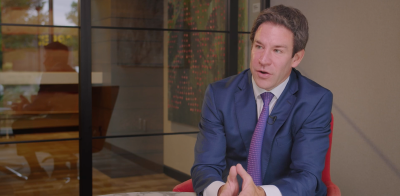In the original “Dare to Dream” strategy note, we discussed a hypothetical macro scenario that could be extremely beneficial for private lending and multi-strategy funds. The Dare to Dream macro scenario (while still not our base case) focuses on the following potential economic and market outcomes:
Reduced inflation—without a recession
As the U.S. economy continues to show remarkable resilience (for now)—in the midst of the most rapid Fed tightening cycle in history, a massively inverted yield curve, stagnating bank lending and evaporating excess savings—there is, at least, a mathematical path to the Fed threading the needle and keeping the U.S. economy out of recession for the foreseeable future.
Remember, the U.S. economy is a consumption economy. And it really all comes down to whether or not the Fed can engineer enough of a softening of the labor market/rise in unemployment to declare victory over inflation without having labor market losses drive the economy into recession. It’s still a tough needle to thread if history is any guide.
How it might happen
The mathematical path to getting there runs through the combination of:
- Investment and construction: Increased business fixed investment and construction spending driven by the Inflation Reduction Act.
- Government spending: The ability for most state and local governments to continue to spend freely.
- A housing market flip: The housing market flipping from a GDP detractor for six quarters to a sustained positive contributor based on hyper-tight supply.
- “Labor hoarding”: Companies becoming highly reluctant to let workers go.
These would all collectively need to provide a positive feedback loop to short-circuit the typical Fed tightening/business cycle endgame where the lagging labor market is the last to break.
For the record: This is not our base case.
It is still more likely than not that the endgame for this cycle is a mild recession—hence the term Dare to Dream.
How multi-strategy funds may benefit from Dare to Dream
In the last strategy note , we focused on the favorable tailwinds and improved opportunity for private lending that can benefit from Dare to Dream. Now we will focus on the way a select group of multi-strategy funds may benefit from the same phenomenon.
As a reminder, multi-strategy investing was one of a handful of strategies that provided attractive absolute returns in 2022 when both equities and bonds were a complete train wreck.
One of the key attributes of any alternative strategy is the potential to protect capital when markets get ugly. Posting low to mid-single digit returns when equities and bonds are simultaneously getting obliterated was even better than protecting capital (a true win for those who embraced noncorrelated return streams and democratized alternatives).
Today, certain multi-strategy funds are on track to generate even higher income and total return so far in 2023, (as we predicted in the year-end 2022 strategy note) while bonds continue to struggle—the Barclay’s Aggregate Bond Index (BAGG) is down yet again in 2023 and equities have recently given back a substantial portion of their first seven months of 2023 gains (the S&P 500 just entered correction territory from the late July highs).
“Higher for longer” drives increased income
In multi-strategy funds that express a substantial portion of their investment themes through futures and total return swap positions, a large percentage of the portfolio’s net asset value (NAV) is parked in cash.
The reason for this is that an investment manager only has to post a small percentage of total position size as margin for futures and total return swap (TRS) exposures, with the excess sitting in cash. When interest rates are at zero, there is no substantial income component.
When interest rates are as high as they are now, the income can boost investor returns.
Since we are clearly in a “higher for longer” interest rate regime, even if Dare to Dream does not fully materialize, investors will enjoy a higher total return potential just from a higher risk-free rate. If the U.S. economy can avoid recession the next several years, the higher total return from a high risk-free rate will drive performance for longer.
“Higher for longer” drives lower refinance activity
As mortgage rates have climbed by almost 5% the past two years , roughly, refinance activity grounded to nearly a complete halt. This in turn has driven higher cash flows for longer in Agency RMBS Interest Only Securities.
Multi-strategy funds that have leaned into the second great secular slowdown in prepayment activity continue to enjoy more sustained income from higher mortgage rates constraining refinance activity for longer. Remember, the first great secular slowdown in refi activity from 2007 through 2012 was driven by massive home price declines and an inability for mortgagors to access lower mortgage rates unless they injected a substantial portion of equity into their home.
This secular slowdown is driven principally by substantially higher mortgage rates, and over time, could be enhanced by further declines in home prices.
How mortgages get “prepaid”
As a reminder, there are basically four drivers for a “prepayment” on a mortgage:
- Homeowner refinancing
- Cash-out refinancing
- Moving
- Extended delinquency
Homeowner refinancing
The primary driver of prepayment activity has always been the incentive for homeowners to refinance their current mortgage at a lower interest rate to save a few hundred dollars per month on their mortgage payment.
With mortgage rates almost 5% higher than the 2020 and 2021 lows, the MBA Refinance Index has dropped by 94.6% since March of 2020 and 90.6% since a more recent refi peak in August of 2021. Since 92% of the current U.S. mortgage universe has a 6% or lower mortgage, it will take a significant and sustained drop in mortgage rates to drive in meaningful pickup in classic refi activity.
Sounds like a lot more income for longer.
Cash-out refinancing
The second driver of prepayment activity has been cash-out refi activity, where a borrower takes equity out of their home and potentially increases their monthly payment.
Cash-out refi activity was robust in the housing bubble of 2004 through the summer of 2006, and picked back up in 2020 and 2021. From 2020 to 2021, cash out refis were driven by artificially low mortgage rates (courtesy of the Fed’s QE program and zero risk-free interest rates), plus median home prices soaring by almost 50%. With mortgage rates so much higher now, and median home prices having dropped by a little over 13% from their recent peak, cash-out refi activity has collapsed.
Again…more income for longer.
Moving
The third driver of prepayment activity is moving from one house to another.
Typically, the existing mortgage is paid off and a new one is taken out on the home to which the new owner moves . Since higher mortgage rates have dramatically reduced the affordability of moving from a home with a lower mortgage rate into a different home with a MUCH higher mortgage rate, existing home sales have declined by approximately 40%.
Thus: More income for longer.
Extended delinquency
Lastly, the fourth driver of prepayment activity historically has been involuntary—through extended delinquencies.
Even though the mortgage in question is not paid off by the borrower, the agencies (Fannie, Freddie and Ginnie) buy the mortgage out of the pool of loans backing an Agency IO. At this point, there is no more income generated for the investor. Thus, in practice, an involuntary delinquency-driven prepayment acts just like a voluntary prepayment caused by the first three drivers we just discussed.
The last great mortgage delinquency wave was driven by the housing market collapse in the GFC when delinquencies reached 11.5% in Q1 2010. Fortunately, delinquencies have now dropped to just 1.7%.
In the Dare to Dream scenario where the economy avoids recession and the labor market stays strong, delinquencies should stay lower than they would in the event of a mild recession or a more severe one. Plus, with massive home price appreciation driving unprecedented homeowner wealth gains, borrowers are much more likely to do everything in their power to avoid delinquency and foreclosure.
The potential benefits of a “higher for longer” environment
In conclusion, a higher for longer environment, without a foregone conclusion of recession, should lead to slower refi/prepayment activity as far as the eye can see. That would mean more income and total return for multi-strategy funds that embrace prepayment-sensitive RMBS.
“Higher for longer” without a recession would drive higher income and better total return for L/S corporate credit and structured credit strategies within multi-strategy funds.
That could mean:
- More income: Higher interest rates potentially drive more income for longer.
- Decreased loss: A possibility of avoiding recession reduces the probability and magnitude of income that is lost through higher realized losses caused by recession-driven defaults.
This is consistent whether the credit instrument is backed by a corporation, a residential mortgage, a consumer loan or commercial properties.
What Dare to Dream may mean for certain multi-strategy investors
Now that we have discussed the potential benefits of Dare to Dream for certain multi-strategy funds, let’s put some math (and context) around what this means for multi-strategy investors.
In some cases, for example, when risk-free was zero and the opportunities in cash flow generative strategies (cash flow is king) were not as attractive as they are today (as recently as January 2022), the income component driving net total return was as low as 0.1%. In certain cases today, it could soon be as high as 6% net of fees.
Now, I’m not the smartest guy in the world but it’s much easier to comprehend how a multi-strategy fund may generate 6% to 10% net returns when you are starting with 6% net income compared to 0.1% net income!
Historically, if a multi-strategy fund generated 2% to 4% of alpha over the past five and three years (return independent of broader market indexes), it could be a reasonable assumption that 3% alpha per annum is achievable.
So, you don’t need the wildest imagination—or a PhD in quantum computing—to figure out how low beta/low duration1 multi-strategy investing may generate a 9% total return in this environment independently of equity and bond market outcomes: You just add 6% net income to 3% alpha, and voila—9% net return.
And remember, the icing on the cake is that now that Alts are democratized, you can access multi-strategy investing through daily liquid 40 Act structures! No need to be a $20 billion endowment or sovereign wealth fund to participate. No need to wait in line for investment capacity, lock up your money for five years or add to your accountant’s workload with another K-1.
Conclusion
While a Dare to Dream scenario is still not our base case, there is a compelling path to the Fed threading the needle and delivering that ideal low-inflation, recession-free outcome. In which case, select multi-strategy funds could be among the strategies that benefit.
In the meantime, the right multi-strategy funds are on track to generate even higher income and total return so far in 2023. And since we are in a “higher for longer” environment, even if Dare to Dream does not fully materialize, investors in those strategies could enjoy higher total return potential with increased income and lower refinance rates.
Investing in alternatives is different than investing in traditional investments such as stocks and bonds. Alternatives tend to be illiquid and highly specialized. In the context of alternative investments, higher returns may be accompanied by increased risk and, like any investment, the possibility of an investment loss. Investments made in alternatives may be less liquid and harder to value than investments made in large, publicly traded corporations. When building a portfolio that includes alternative investments, financial professionals and their investors should first consider an individual’s financial objectives. Investment constraints such as risk tolerance, liquidity needs and investment time horizon should be determined.


